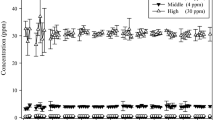Abstract
Naphthalene metabolism and toxicity have been extensively investigated and these data indicate that the lung and eye toxicity are mediated by reactive intermediates. The elegant studies conducted in Buckpitt’s laboratory implicate a 1,2-epoxide as one reactive intermediate which is extensively conjugated with glutathione (Buckpitt et al., 1987). Data from this laboratory also suggest that the liver may form a precursor metabolite or reactive metabolite which is transported to the lung (Buckpitt and Warren, 1983). Studies of the ocular effects of naphthalene suggest that the well known liver metabolite, naphthalene-1,2-ihydrodiol (DIOL), may be transported to the eye where it is oxidized to the catechol metabolite, 1,2-dihydroxynaphthalene (VanHeyningen and Pirie, 1967). The catechol is easily oxidized non-enzymatically presumably to potentially reactive quinones and semiquinones. A more recent report also suggests the involvement of quinones in the ocular toxicity of naphthalene (Wells et al., 1989) and an in vitro study indicates that multiple quinone-derived metabolites are formed from D1OL when its oxidation is catalyzed by hepatic dihydrodiol dehydrogenase (Smithgall et al., 1988). Naphthalene is extensively metabolized and at least two epoxides as well as the the catechol/quinone metabolites are potentially reactive, toxic metabolites (Horning et al., 1980).
Access this chapter
Tax calculation will be finalised at checkout
Purchases are for personal use only
Preview
Unable to display preview. Download preview PDF.
Similar content being viewed by others
References
Billings, R.E. (1985). Mechanisms of catechol formation from aromatic compounds in isolated rat hepatocytesDrug. Metab. Disp. 13, 287–290.
Buckpitt, A.R. and Warren, D.L., 1983. Evidence for hepatic formation, export and covalent binding of reactive naphthalene metabolites in extrahepatic tissues in vivo. J.Pharmacol. Exp. Ther. 225, 8–16.
Buckpitt, A.R., Bahnson, L.S. and Franklin, R.B., 1984. Hepatic and pulmonary microsomal metabolism of naphthalene to glutathione adducts: Factors affecting the relative rates of conjugate formation. J. Pharmacol. Exp. Ther. 232, 291–300.
Buckpitt, A.R., Castagnoli, N. Nelson, S.D., Jones, A.D. and Bahnson, L.S. (1987). Drug. Metab. Disp. 15, 491–498.
Dankovic, D., Billings, R.E., Seifert, W. and Stillwell, W.G. (1985). Bromobenzene metabolism in isolated rat hepatocytes: incorporation studies. Mol. Pharmacol. 27, 287–295.
Green, C.E., Dabbs, J.E. and Tyson, C. (1983). Functional integrity of isolated rat hepatocytes prepared by whole liver vs. biopsy perfusion. Anal. Biochem. 129, 269–276.
Horning, M.G., Stillwell, W.G., Griffin, G.W. and Tsang, W.-S. (1980). Epoxide intermediates in the metabolism of naphthalene by the rat. Drug Metab. Disp. 8, 404–414.
Ku, R.H. and Billings, R.E. (1986). The role of mitochondrial glutathione and cellular protein sulfhydryls in formaldehyde toxicity in glutathione toxicity in glutathione-depleted rat hepatocytes. Arch. Biochem. Biophys. 247, 183–189.
Smithgall, T.E., Harvey, R.G., and Penning, T.M. (1988). Spectroscopic identification of quinones as the products of polycyclic aromatic trans-dihydrodiol oxidation catalyzed by dihydrodiol dehydrogenase. A potential route of proximate carcinogen metabolism. J.Biol. Chem. 263, 1814–20.
VanHeyningen, R. and Pirie, A. (1967). The metabolism of naphthalene and its toxic effect on the eye. Biochem. J. 102, 842–852.
Warren, D.L., Brown, D.L. and Buckpitt, A.R. (1982). Evidence for cytochrome P-450 mediated metabolism in the bronchiolar damage by naphthalene. Chem. Biol. Interactions. 40, 287–303.
Wells, P.G., Wilson, B. and Lubek, B.M. (1989). In vivo murine studies on the biochemical mechanism of naphthalene cataractogenesis. Toxicol. Appt. Pharmacol. 99, 466–473.
Author information
Authors and Affiliations
Editor information
Editors and Affiliations
Rights and permissions
Copyright information
© 1991 Plenum Press, New York
About this chapter
Cite this chapter
Billings, R.E., Miller, N.E., Dabbs, J.E., LeValley, S.E., Hill, J.R., Green, C.E. (1991). Comparison of the Toxicity of Naphthalene and Naphthalene-1,2-Dihydrodiol (DIOL). In: Witmer, C.M., Snyder, R.R., Jollow, D.J., Kalf, G.F., Kocsis, J.J., Sipes, I.G. (eds) Biological Reactive Intermediates IV. Advances in Experimental Medicine and Biology, vol 283. Springer, Boston, MA. https://doi.org/10.1007/978-1-4684-5877-0_86
Download citation
DOI: https://doi.org/10.1007/978-1-4684-5877-0_86
Publisher Name: Springer, Boston, MA
Print ISBN: 978-1-4684-5879-4
Online ISBN: 978-1-4684-5877-0
eBook Packages: Springer Book Archive




